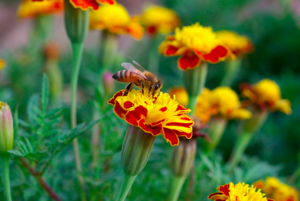
Marigold (Calendula officinalis, Asteraceae family) is a hardy annual herb with a bright countenance. Although it is a herb, many gardeners now grow it solely as a flower.[1]
Marigolds originated in sub-tropical America.[2] The French marigold grows wild in the Mediterranean region, tolerating many soil types. The African marigold is taller than the French version.[3]
Description[edit | edit source]
Marigold has soft, bright green leaves.
The flowers are golden-orange, yellow, sometimes streaked with maroon and a combination of each of these colours.
The plant is highly aromatic, its odour being quite refreshing and sharp.
Growing marigold[edit | edit source]
Decide between growing from seed or seedlings. Seed can be sown in autumn for early spring growth or in spring for summer growth. Seedlings can be transplanted directly to where you want them to grow, usually without any fuss. Marigold can also be grown with ease in a container.
Choose a sunny position to grow marigold. Marigold can tolerate some shade; however, a major benefit of this plant is its ability to tolerate both full sun and plenty of heat.[3]
While marigold is able to cope with many soil types, it grows best in soil that well-drained and loamy. Add a lot of organic matter.[2]
Deadhead the plant regularly to encourage new growth and flowering. However, by wintertime, the plant will die down. Rescue the seeds if you want to plant them. Cuttings can be made and left to form roots in water, then grown indoors with care over winter, providing a source of ready-made seedlings for the early spring.
Marigold reseeds itself with ease but new growth from seeds can be prevented if weed plants are allowed to take over the garden space where they seeded.
Problems[edit | edit source]
Marigolds are fairly resistant to insects but they can attract spider mites in dry, hot weather.[2]
Other problems that may be experienced by marigolds include: Aster yellows, fungal rot and grasshoppers.[2] If the marigolds have been infected by aster yellows or fungal rot, dig them out of the soil and dispose of as garbage. Do not compost the plants as this can spread the disease.
Herbivores may eat marigolds if they have access to them.
Uses for marigold[edit | edit source]
Companion planting[edit | edit source]
Marigolds are often used for companion planting as it has long been considered that they can keep away some garden pests, such as whitefly. However, other gardeners consider that marigold may actually attract insects to the vegetable patch, especially spider mites, so beware![4] The spider mites are attracted most when the weather is dry and hot, and can be easily washed off with a squirt.[3] French dwarf marigolds do have some ability to deter certain nematodes in the soil but they may only repel the nematodes for their own needs rather than assisting neighbouring plants.[4]
Landscaping[edit | edit source]
Use in landscaping for the following:
- Rockeries
- Mass of colour
- Borders and edges
- Containers.
Household use[edit | edit source]
Marigolds make pretty flowers when cut for vases and other floral displays.
The petals can be added to salads, as they are edible.[5] They can also add flavour and colour to stir-fries, rice dishes, baked items and soups.[5]
Sources and Citations[edit | edit source]
- ↑ http://www.extension.iastate.edu/article/yard-and-garden-marigolds
- ↑ 2.0 2.1 2.2 2.3 http://www.clemson.edu/extension/hgic/plants/landscape/flowers/hgic1168.html
- ↑ 3.0 3.1 3.2 http://www.ext.colostate.edu/ptlk/1036.html
- ↑ 4.0 4.1 http://web.archive.org/web/20181021212904/http://www.aces.edu:80/dept/extcomm/specialty/marigolds.html
- ↑ 5.0 5.1 http://www.motherearthnews.com/organic-gardening/marigold-uses-zmaz83jazshe.aspx